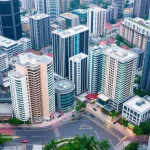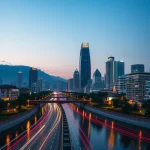
 District 1 may be the busiest section of Ho Chi Minh City. It’s the administrative, financial and commercial heart from the city. Mind offices of huge banks, consulates and costly eateries are located here.
District 1 may be the busiest section of Ho Chi Minh City. It’s the administrative, financial and commercial heart from the city. Mind offices of huge banks, consulates and costly eateries are located here.
District 1 would be a prime area even throughout the French Indochina period, apparent within the French-styled structures grouped here. Structures like the Saigon Notre-Dame Basilica, the Central Publish Office, City Hall, and also the Saigon Opera House provide a great eye-chocolate for visitors interested in in france they influence within the city. Other great spots to go to would be the Reunification Palace and Phạm Ngũ Lão Street.
The Saigon Notre-Dame Basilica (Vương Cung Thánh Đường Sài Gòn or Nhà thờ Đức Bà Sài Gòn) was built through the French settlers, who wanted an edifice that does not only extolled Christianity but the greatness of French civilization. The church is a mixture of Roman and Medieval elements and during the time of construction, was probably the most beautiful structures in Cochinchina. All the original materials were imported from France, like the outdoors red bricks from Marseille, but local sources have mended areas of the cathedral broken by war. A statue from the Virgin Mary was stated to possess shed tears in October 2005. Although the Church has confirmed the falsity of the alleged miracle, the statue still remains a well known curiosity for visitors. The vista in the belfry towers is among the very best in the town.
Near the Basilica is a vital Publish Office, created by Gustave Eiffel. The skylight, the central pavilion, the large beautiful old clock, and also the detailed ironwork that frames the primary entrance are great aspects of the Renaissance-inspired building. Today, the Central Publish Office not just transmits mail, but has internet and make contact with services.
The Hôtel de Ville de Saigon or even the Ho Chi Minh’s City Hall (Trụ sở Ủy ban Nhân Thành phố Hồ Chí Minh), though not available to the general public, is yet another beautiful French building. The executive office was built between 1902 and 1908. It’s superbly lit at night.
 The Saigon Opera House (Nhà hát lớn Thành phố Hồ Chí Minh) is yet another fine illustration of French colonial architecture. The gorgeous building was utilized for that Lower House Set up from the Republic of Vietnam from 1956 to 1995. Its design was greatly affected by the colourful type of in france they Third Republic. Its facade was renovated in celebration of their 300th anniversary in 1998.
The Saigon Opera House (Nhà hát lớn Thành phố Hồ Chí Minh) is yet another fine illustration of French colonial architecture. The gorgeous building was utilized for that Lower House Set up from the Republic of Vietnam from 1956 to 1995. Its design was greatly affected by the colourful type of in france they Third Republic. Its facade was renovated in celebration of their 300th anniversary in 1998.
The Reunification Palace (Dinh Thống Nhất) is a great place to discover the Vietnam’s short-resided stint like a democracy. Once known as the Independence Palace, this historic landmark was the office and home from the President of South Vietnam throughout the Vietnam War. It had been here the official handover of power required place during nov Saigon in 1975. Created by architect Ngo Viet Thu, the complex covers 12 hectares, together with a palace by having an 80-metre-wide facade, “homes” that may accommodate 800 visitors, and enveloping gardens and lawns. The palace started construction in 1863 and it was initially named Norodom Palace following the king of Cambodia at that time.
You will find five-star hotels in District 1 and accommodations for budget vacationers. Phạm Ngũ Lão street is called khu tay ba lo—a backpackers’ area. It’s hostels, guesthouses, bars, cafés, and bargain shops that sell clothes, souvenirs and DVDs.
Ben Thanh Marketplace is the region for local crafts and trinkets. It’s a number of informal market stalls established like a formal market in 1859. It’s a good way to test some local cuisine too.
Dhong Khoi
 Dhong Khoi in District 1 is a vital shopping lane. While it doesn’t yet match Singapore’s Orchard Road, it will have a wide range of products, including pricy products of excellent quality. Sheraton Hotel at one finish contains numerous worldwide acclaimed brands, while all of those other street has smaller sized shops, numerous bars and a few restaurants. There are other fashion and souvenir finds in posh Hai Ba Trung.
Dhong Khoi in District 1 is a vital shopping lane. While it doesn’t yet match Singapore’s Orchard Road, it will have a wide range of products, including pricy products of excellent quality. Sheraton Hotel at one finish contains numerous worldwide acclaimed brands, while all of those other street has smaller sized shops, numerous bars and a few restaurants. There are other fashion and souvenir finds in posh Hai Ba Trung.
Dong Khoi is among the bigger avenues in Ho Chi Minh City, and connects to Le Loi, another primary road.
Resourse: http://globalpropertyguide.com/





